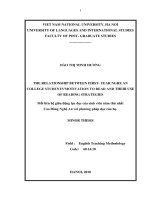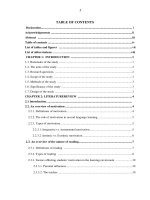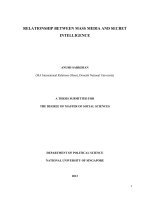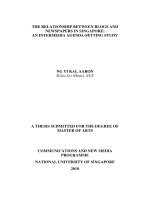- Trang chủ >>
- Sư phạm >>
- Sư phạm sinh
Doctor of Philosophy in Business Administration: The roles of student trust, identity and commitment in the relationship between university reputation and behavioral intention - TRƯỜNG CÁN BỘ QUẢN LÝ GIÁO DỤC THÀNH PHỐ HỒ CHÍ MINH
Bạn đang xem bản rút gọn của tài liệu. Xem và tải ngay bản đầy đủ của tài liệu tại đây (325.61 KB, 20 trang )
<span class='text_page_counter'>(1)</span><div class='page_container' data-page=1>
<b>MINISTRY OF EDUCATION AND TRAINING </b>
<b>UNIVERSITY OF ECONOMICS HO CHI MINH CITY </b>
<b>--- </b>
<b> BUI HUY KHOI </b>
<b>The roles of student trust, identity </b>
<b>and commitment in the relationship </b>
<b>between university reputation and </b>
<b>behavioral intention </b>
<b>A dissertation submitted for the Degree of </b>
<b>Doctor of Philosophy in Business Administration </b>
</div>
<span class='text_page_counter'>(2)</span><div class='page_container' data-page=2>
<b>MINISTRY OF EDUCATION AND TRAINING </b>
<b>UNIVERSITY OF ECONOMICS HO CHI MINH CITY </b>
<b>--- </b>
<b> BUI HUY KHOI </b>
<b>The roles of student trust, identity </b>
<b>and commitment in the relationship </b>
<b>between university reputation and </b>
<b>behavioral intention </b>
<b>Industry: Business Administration </b>
<b> </b> <b> Industry ID: 9340101 </b>
<b>A dissertation submitted for the Degree of </b>
<b>Doctor of Philosophy in Business Administration </b>
<b> Academic Supervisors: </b>
<b> Dr. Nguyen Huu Lam </b>
<b> </b> <b>Dr. Dang Ngoc Dai </b>
</div>
<span class='text_page_counter'>(3)</span><div class='page_container' data-page=3>
<b>STATEMENT OF AUTHORSHIP </b>
I please declare that this submission is my work and except where due
reference is made; this dissertation contains no material previously published or
written by another person(s).
This dissertation does not contain material extracted in the whole or part
from the dissertation or report presented for another degree or diploma in University
of Economics Ho Chi Minh city or any other educational institution.
January 2021
</div>
<span class='text_page_counter'>(4)</span><div class='page_container' data-page=4>
<b>ACKNOWLEDGMENT </b>
First of all<b>, </b>this dissertation is dedicated to the thank of my wife-Nguyen Thi
Ngan, to my daughter-Bui Mai Anh (9 years), my daughter-Bui Mai Vy (6 years),
my son-Bui Minh Nhat (4 years), and to my son-Bui Minh Hoang (4 years). They
help me have many efforts to overcome difficulties in completing my dissertation. It
is the biggest achievement of my life.
Second, I would like to express my best gratitude to Ph.D. Nguyen Huu Lam
and Ph.D. Dang Ngoc Dai, who supervise and help me conduct my dissertation for
many years at University of Economics HCM City.
Third, I am deeply thankful to Prof. Vladik Kreinovich, University of Texas,
USA for supporting me to publish my paper related to my dissertation in the Scopus
system.
Especially, I would express my gratefulness to Ph.D. Ngo Quang Huan,
University of Economics HCM City and Ph.D. Nguyen Thanh Long, Industrial
University of HCM City who indirectly or directly support and help me conduct the
dissertation. Moreover, I am thankful to the board of professors in School of UEH
Graduate, the independent reviewers for their constructive reviewing and
comments.
</div>
<span class='text_page_counter'>(5)</span><div class='page_container' data-page=5>
<b>TABLE OF CONTENT</b>
STATEMENT OF AUTHORSHIP ... i
ACKNOWLEDGEMENT ... ii
TABLE OF CONTENT ... iii
LIST OF ABBREVIATIONS ... vii
LIST OF TABLES ... viii
LIST OF FIGURES ... ix
ABSTRACT ... x
TÓM TẮT ... xi
CHAPTER 1. RESEARCH OVERVIEW ... 1
1.1. Introduction ... 1
1.2. Research background ... 1
1.3. The research gap identification ... 9
1.4. Research object and scope ... 10
1.4.1. Research object ... 10
1.4.2. Research scope ... 11
1.5. Research aim ... 11
1.6. The research questions ... 13
1.7. Methodology ... 13
1.8. Dissertation contributions ... 14
1.8.1. Theory contributions ... 15
</div>
<span class='text_page_counter'>(6)</span><div class='page_container' data-page=6>
1.9. Dissertation structure ... 17
1.10. Conclusion ... 18
CHAPTER 2. LITERATURE REVIEW ... 19
2.1. Introduction ... 19
2.2. Reputation ... 19
2.2.1. Student guidance ... 28
2.2.2. Social contributions ... 29
2.2.3. Environments ... 31
2.2.4. Leadership ... 32
2.2.5. Funding ... 33
2.2.6. Research and development ... 33
2.3. Student trust ... 34
2.4. Student identity ... 35
2.5. Student commitment ... 37
2.6. Behavioral intention ... 38
2.7. Foundation theories ... 43
2.7.1. Market signaling theory ... 43
2.7.2. The theory of planned behavior (TPB) ... 45
2.7.3. Theory of reasoned action (TRA) and extended valence framework ... 50
2.8. The research model and hypotheses ... 51
2.8.1. Factors affecting university reputation ... 51
2.8.2. The roles of student trust, student identity, and student commitment ... 53
</div>
<span class='text_page_counter'>(7)</span><div class='page_container' data-page=7>
CHAPTER 3. METHODOLOGY ... 64
3.1. Introduction ... 64
3.2. The research process ... 64
3.3. Sample and data collection... 97
3.4. PLS-SEM ... 100
3.5. Quantitative analysis frame ... 104
3.6. Conclusion ... 106
CHAPTER 4. RESULTS ... 107
4.1. Introduction ... 107
4.2. Internal consistency and convergent validity ... 107
4.3. Indicator reliability ... 108
4.4. Discriminant validity ... 110
4.5. Collinearity issue ... 112
4.6. The fitness of the structural model ... 113
4.7. Stability of parameter estimates ... 116
4.8. Discussion ... 119
4.9. Conclusion ... 120
CHAPTER 5: CONCLUSIONS AND MANAGERIAL IMPLICATIONS ... 121
5.1. Introduction ... 121
5.2. Conclusions ... 121
5.3. Key Contributions ... 122
5.4. Contributions to methodology... 124
</div>
<span class='text_page_counter'>(8)</span><div class='page_container' data-page=8>
5.6. Implications ... 126
5.6.1. Practical Implications ... 126
5.6.2. Implications for domestic manager ... 128
5.6.3. Implications for university manager ... 128
5.7. Limitations and recommendations for further research ... 135
PUBLICATION ... 137
REFERENCES ... 138
APPENDIX ... 159
</div>
<span class='text_page_counter'>(9)</span><div class='page_container' data-page=9>
<b>LIST OF ABBREVIATIONS</b>
<b>Abbreviation </b> <b>Meanings </b>
HEIs Higher education institutions
PLS-SEM Partial least squares structural equation modelling
UR University Reputation
SG Student Guidance
SCN Social Contributions
EN Environments
LE Leadership
FU Funding
RD Research and Development
ST Student Trust
SI Student Identity
SC Student Commitment
BI Behavioral Intention
H Hypothesis
TRA The theory of reasoned action
TBP The theory of planned behavior
Pc The composite reliability
Pvc The average variance extracted
SRMR The standardized root mean square residual
OL Outer loading
</div>
<span class='text_page_counter'>(10)</span><div class='page_container' data-page=10>
<b>LIST OF TABLES </b>
Table 2.1. Variables and their proposing authors. ... 41
Table 2.2. Summary of the correlations in the model.. ... 61
Table 3.1. The discussion group code. ... 68
Table 3.2. Social Contributions’ items ... 75
Table 3.3. Environments’ items. ... 77
Table 3.4. Leadership’s items. ... 78
Table 3.5. Funding’s items. ... 79
Table 3.6. Research and Development’s items. ... 81
Table 3.7. Student Guidance’s items... 82
Table 3.8. Student Trust’s items. ... 83
Table 3.9. Student identity’s items. ... 84
Table 3.10. Student Commitment’s items. ... 85
Table 3.11. Behavioral Intention’s items. ... 86
Table 3.12. Items and factors in the reputation scale. ... 90
Table 3.13. Item and factor in the university reputation scale. ... 95
Table 3.14. University Reputation’s items. ... 96
Table 3.15. Sample Statistics. ... 99
Table 4.1. Internal consistency and convergent validity... ... 107
Table 4.2. Outer Loadings. ... 109
Table 4.3. Fornell-Larcker Criterion.. ... 111
Table 4.4. Inner VIF Values. ... 112
Table 4.5. Measurement of model PLS-SEM. ... 115
Table 4.6. Path Coefficients. ... 116
</div>
<span class='text_page_counter'>(11)</span><div class='page_container' data-page=11>
<b>LIST OF FIGURES </b>
Figure 2.1. Valence Framework Model ... 51
Figure 2.2. The model of Keh and Xie (2009) ... 54
Figure 2.3. The model of Rather (2018) ... 55
Figure 2.4. The model of Heffernan et al. (2018) ... 56
Figure 2.5. The model of Nuraryo et al. (2018) ... 57
Figure 2.8. The theoretical model ... 61
Figure 3.1. The process of quantitative analysis ... 105
</div>
<span class='text_page_counter'>(12)</span><div class='page_container' data-page=12>
<b>ABSTRACT </b>
This dissertation aims to investigate and explore the roles of student trust
(ST), student identity (SI), and student commitment (SC) in a relationship between
the reputation of a university (UR) and its students’ behavioral intention (BI) in
Vietnam's higher education sector. The dissertation builds an empirically tested
model from a sample of 1,538 Vietnamese graduates. Its purpose determines the
factors affecting university reputation and the roles of student trust, student identity,
and student commitment in the relationship between university reputation and
behavioral intention to understand student choices of master’s programs. Next,
these factors will be measured by some analysis quantitative tools. Finally, this
dissertation will also give some implications to develop the relationship between
university reputation and behavioral intention in Vietnamese higher education. The
analysis results revealed that the tested relationship between university reputation
and behavioral intention to continue studying is positive. Twelve of the proposed
hypotheses were confirmed, including the direct relationship of the variables and
the mediating role of SI, SC, and ST in the model. The results suggest that a
university reputation can be a driving force toward students’ behavioral intention to
achieve positive goals in the development of their higher education. This
dissertation significantly contributes to the understanding of university reputation
and student behavioral intention in higher education. In both theory and practice, it
provides vital findings and suggestions to scientists, university administrators, and
strategic marketers applying in their working environment.
</div>
<span class='text_page_counter'>(13)</span><div class='page_container' data-page=13>
<b>TÓM TẮT </b>
Luận án này nhằm mục đích khám phá và kiểm tra vai trò của niền tin (ST),
nhận biết (SI) và cam kết (SC) của sinh viên trong mối quan hệ giữa danh tiếng
trường đại học (UR) và dự định hành vi của sinh viên (BI) tốt nghiệp đại học trong
bối cảnh giáo dục sau đại học tại Việt Nam. Luận án xây dựng một mơ hình được
kiểm nghiệm từ thực tế trong một mẫu nghiên cứu gồm 1.538 sinh viên tốt nghiệp
đại học ở Việt Nam. Mục đích của luận án là xác định các yếu tố ảnh hưởng đến
danh tiếng trường đại học và vai trò của niền tin, nhận biết và cam kết của sinh viên
trong mối quan hệ giữa danh tiếng trường đại học và dự định hành vi để hiểu sự lựa
chọn của sinh viên đối với các chương trình đào tạo thạc sĩ. Ttiếp theo, các yếu tố
này sẽ được đo lường bằng một số cơng cụ phân tích định lượng. Cuối cùng, luận án
cũng sẽ đưa ra một số hàm ý quản trị nhắm phát triển mối quan hệ giữa danh tiếng
trường đại học và dự định hành vi trong giáo dục sau đại học tại Việt Nam. Kết quả
phân tích cho thấy mối quan hệ đã được kiểm định giữa danh tiếng trường đại học
và hành vi có dự định tiếp tục lựa chon việc học tập là tích cực. Mười hai giả thuyết
được đề xuất đã được xác nhận, bao gồm mối quan hệ trực tiếp của các yếu tố và
vai trò trung gian của niền tin (ST), nhận biết (SI) và cam kết (SC) của sinh viên
trong mơ hình cũng được xác nhận. Kết quả cho thấy danh tiếng trường đại học có
thể là động lực thúc đẩy dự định hành vi của sinh viên nhằm đạt được các mục tiêu
tích cực trong sự phát triển giáo dục sau đại học của họ. Luận án này góp phần đáng
kể vào sự hiểu biết về danh tiếng trường đại học và dự định hành vi của sinh viên
trong giáo dục sau đại học. Về cả lý thuyết và thực tế, nó cung cấp những phát hiện
và đề xuất quan trọng cho các nhà khoa học, các nhà quản trị trường đại học và các
nhà tiếp thị chiến lược ứng dụng vào mơi trường làm việc của mình.
</div>
<span class='text_page_counter'>(14)</span><div class='page_container' data-page=14></div>
<span class='text_page_counter'>(15)</span><div class='page_container' data-page=15>
<b>CHAPTER 1. RESEARCH OVERVIEW </b>
<b>1.1.</b>
<b>Introduction </b>
This dissertation shows the roles of student trust, identity and commitment in the
relationship between university reputation and behavioral intention in Vietnamese
higher education. I present standard information about the studied problem and
dissertation background, and I identify the dissertation’s aims and research questions.
This chapter also briefly describes the dissertation structure.
<b>1.2.</b>
<b> Research background </b>
QS University Rankings for Asian 2021 based on 11 different criteria to evaluate
one university, including academic reputation (30%), employer reputation (20%),
lecturer/ student ratio (10 %), percentage of lecturers with doctoral degrees (5%), ratio
of published papers per lecturer (5%), citations per paper (10%), international research
network (10%), international lecturer ratio (2.5%), international student rate (2.5%),
domestic exchange students (2.5%), and foreign exchange students (2.5%) (Duong
Tam, 2020). Vietnam has 11 universities participating in the QS University Rankings
for Asian 2021(QS, 2020). So, reputation is the most important key for ranking a
university and that is a reason which Vietnamese universities are creating, building,
and developing it.
</div>
<span class='text_page_counter'>(16)</span><div class='page_container' data-page=16>
has been embraced by the higher education sector, in which education is seen as a
service that is marketable worldwide. Universities and other institutions of higher
education must compete to attract highly talented students, prestigious professors, and
effective employees (Del-Castillo-Feito et al., 2020; Hemsley-Brown et al, 2016;
Nuraryo et al., 2018; Plewa et al., 2016; Wilson, 2016). Some individuals credit the
globalization of universities to the many changes and difficulties that the educational
sector is now facing. Despite differences in opinion, school leaders and various other
commentators agree that competition between higher education institutions has
intensified over the last few years (Chen and Esangbedo, 2018; Plewa et al., 2016).
Education plays an enormous role in a country’s development, and its progress in a
given country partly symbolizes that country’s growth in general (Chen and
Esangbedo, 2018).
Higher education institutions play an important role in society: they are essential
partners of the knowledge-creation and knowledge-exchange networks, and they
catalyze innovation, supply tangible benefits of research, and provide consulting and
advisory services. Universities are meant to foster progress, build social capital,
prepare students for outside realities, provide access to knowledge, and extend the
bounds of justice, thereby contributing to the creation and maintenance of a democratic
and sustainable society. However, the increasingly competitive and dynamic nature of
educational environments raises many challenges, such as declining enrollment.
(Dzimińska et al., 2018).
</div>
<span class='text_page_counter'>(17)</span><div class='page_container' data-page=17>
RGDP of Vietnam was 2,563 U.S. dollars (USD) in 2018. In contrast to most other
ASEAN member states, their youth literacy rates are relatively high (Salmi, 2019). The
Vietnamese general education system is divided into three levels: primary education
(grades 1–5), lower secondary education (grades 6–9), and upper secondary education
(grades 10–12). Higher education in Vietnam consists of universities and academies,
which are classified into three categories: public-, private-, and foreign-related. In
2018, Vietnam had 454 HEIs, including 95 private universities and schools, and there
were 2.2 million students in higher education (MOET, 2019).
Vietnam's higher education environment has changed dramatically after two
decades of rapid growth. The number of students, institutions, and faculty members has
risen dramatically, and a further aspect of the system's evolution has been the advent of
a private education sector. Such improvements have significantly led to economic
growth and social progress. However, improvements have occurred more slowly in the
governance systems and leadership modes of the framework — a fact that presents
certain pressing issues for the future of the system (Salmi, 2019). As in other
developing nations, economic reforms in Vietnam (which began in 1986) are strongly
linked to the higher education sector. After 33 years of economic reform policy, the
master’s training program in Vietnam has increased remarkably quickly. Having begun
in 1976 (Hoang Thi Phuong Thao, 2014), the program now encompasses 105,000
students across 180 domestic universities and 212 programs with various joint-training
forms (bachelor’s and master’s degrees) and includes partnerships with many reputable
global universities and educational institutions (Chen et al., 2017).
</div>
<span class='text_page_counter'>(18)</span><div class='page_container' data-page=18>
success becomes uncertain. Increasingly intense competition between institutions has
made every university aware of the need to fully exploit its assets, maximize
performance, and develop a competitive advantage. One way to achieve this has been
to develop a reputable name and build trust in the eyes of students (Harahap et al.,
2018). When a university has an excellent reputation, students will select that
university when enrolling in higher education.
In the competition between universities, reputation can be considered one of the
most vital issues because it is viewed as an upper hand that competitors can mimic only
with significant effort (Chun et al., 2005; Hall, 1992). It is believed that an enterprise’s
intangible attributes, such as reputation, are longer-term and more sustainable than the
qualities of products or services, and are thus more helpful in giving businesses a
competitive advantage. Reputation is one of the essential factors affecting customers'
attitudes and behaviors because what people know and believe regarding an
organization strongly affects their reactions to that organization. Because of
reputation’s importance as a valuable intangible asset, businesses must manage it
carefully, understanding both its strategic importance and the potential factors that
could enhance it (Berens and Van Riel, 2004).
</div>
<span class='text_page_counter'>(19)</span><div class='page_container' data-page=19>
university (Aula, 2015). Hence, the question arises of how to best develop a solid
reputation in higher education.
Much research has been conducted on the influence of a university’s reputation.
This research showed that a college’s repute is the first mark of a school’s uniqueness
(Hemsley-Brown et al, 2016). With the verification of this “brand” theory, reputation
grows even more central to promoting a university’s identity and increasing its
attractiveness in globally competitive conditions.
Although the university’s reputation is becoming a necessary part of globalized
higher education, helping it attract students, staff, and research investments (Chen and
Esangbedo, 2018), the breadth of university reputation’s effect is a contested matter,
largely due to a lack of consensus regarding the relationship between reputation and
behavior.
Research about organizations’ reputations takes two directions. The first is
concerned with factors affecting the reputation itself, and the second is concerned with
the effects of reputation on other relationships.
</div>
<span class='text_page_counter'>(20)</span><div class='page_container' data-page=20>
results confirmed their proposed hypotheses on the relationships with university
reputation; nevertheless, the stakeholder group's moderating impact was not verified.
The discoveries of Del-Castillo-Feito et al. (2020) showed additional empirical
evidence has been given for the relationship between the variables considered, as well
as for the importance of taking more than one stakeholder group into account for
review. They indicated that university reputation was impacted by the following
factors: performance, innovation, citizenship, services, governance, and workplace
climate. This knowledge may be applied by administrators to boost the reputation of
their university.
A study conducted by Esangbedo and Bai (2019), additional research in the same
direction, tested reputation as a benchmark for universities’ continuous improvement.
In multicriteria decision making, the calculation of each criterion’s weight is essential
for the accurate evaluation of research outcomes. Esangbedo and Bai defined
university reputation, assigning it six components: social contributions, environments,
leadership, funding, R&D, and student guidance.
A third example is a research by Plewa et al. (2016), which highlighted the critical
role of a reputation for HEIs. The article offered insight into how brand prestige played
a key role in determining student–university identity. The more attractively the
university’s identity was by students, the more strongly they would identify with the
university, leading to goals, identities, and values shared between the university and the
students. The authors recommended that universities should engage in branding
activities that develop a strong student–university identity to enhance the students'
university-supportive behaviors (Plewa et al., 2016).
</div>
<!--links-->









